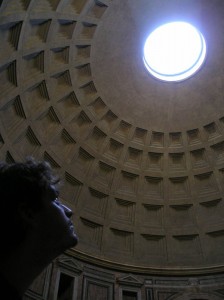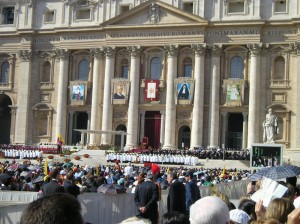I had forgotten how incredible Rome is.
Caution – The Eternal Post: This post will be long and may contain a brief discussion of non-Euclidean geometry. You have been warned.
For 500 years, Rome was the most important place in the world in a way that no other city ever was before, and it seems doubtful that any city will ever be again. The world is simply too decentralized and multipolar today.
Since my overnight train got in really early in the morning, I had to wait until the guy I was staying with got off work. Wandering around Rome, without any real plan, I stumbled upon the Basilica Santa Maria degli Angeli e dei Martiri, which turned out to be the ruins of an enormous Roman baths complex that had been renovated by Michaelangelo into a beautiful basilica. The point is that Rome is absolutely lousy with stuff like this, and you can’t turn around without tripping over a stunning Roman ruin, or a priceless work by a Renaissance master or a Catholic church built out of solid gold or something. Rome has a metro system, but its very small and perfunctory for a city of this size, with only two lines that don’t really go very many places. It’s like somebody told them that major cities need to have a metro, so they built one. Anyway, they’re finally building a third metro line, but the signs for the construction read “ARCHAEOLOGICAL EXCAVATION … (and metro line 3 construction)” which is just a testament to the realization that any time you dig anywhere in Rome, it becomes an archeology expedition.
After the basilica, I walked over the the Italian national library. I like libraries, they’re like churches of knowledge. Both the British Library in London and the Library of Congress in Washington DC are enormous, imposing structures with classical pretensions. I was expecting something similar from the Italian Biblioteca Nationale, but I wound up being disappointed. The building itself is fairly large, but it’s modern architecture and not particularly impressive. It looks more like an office building than a temple. On the other hand, I suppose Rome figures it has absolutely nothing to prove when it comes to classical architecture.
On the other hand, the Italians were much nicer about letting me into the reading rooms than, say, the British. In order to get a reader’s card at the British Library, I needed a note from my history professor to the effect that I needed certain resources (namely a 1992 Irish economic report) which were not available elsewhere in the UK. To get into the Biblioteca, I just filled out a form and showed them an ID. I got a nice little library card too; I think I’ll start collecting them.
The collection itself seemed quite good. I flipped through a journal of Semiotics in the humanities reading room; in the pure science/mathematics reading room I read several chapters of a very good book by one Morris Kline entitled “Mathematics for the Nonmathematician” (I just now found that several chapters are available online as PDFs, chapter 1, 2, 6). Despite being somewhat dated: 1967 copyright; sample logic puzzle: “Two married couples need to cross a river using a boat that only carries two people; how can this be accomplished without leaving a woman alone with a man who is not her husband?”, it did a good job of presenting some fairly complex mathematical concepts in a way that was neither dumbed-down nor inaccessible. One thing I’ll say for academic works from the 1950s/60s, they assumed that university students could pull their own weight without a lot of handholding. Klien’s book, geared as it is toward nonmathematicians, also delves deeper into the social and epistemological implications of the topics he covers than the typical math textbook.
Particularly interesting was the chapter on non-Euclidean geometry. Kline makes a case that the discovery of non-Euclidean geometry represents the single most “fundamental and…far-reaching” revolution in human thought since the 1800s. He argues that prior to the arrival of non-Euclidean geometries, it was almost universally believed that mathematics (and Euclidean geometry in particular) represented real, fundamental truths about the universe, rather than being simply one of a number of internally consistent logical systems that are useful in certain situations.
He does a good job of starting with the parallel postulate and then showing how by changing the assumptions made about parallel lines, you wind up with different geometries. He also touches on some of their applications such as curved surfaces (i.e. globes) and relativistic space-time.
Anyway, later I met up with Carlos and we went out to dinner with his girlfriend and some of her colleagues at a social co-op pizzeria. Then, on Saturday he showed me around the city a little bit. I had done a lot of the standard tourist stuff on my first visit to Rome two years ago, so we skipped that. We went to Jewish quarter, which is very nice. It has quite a different feel from the rest of Rome. It’s much calmer and quieter, in contrast to the noise, bustle and insane traffic of the rest of the city center. Carlos said he actually really dislikes living in Rome, but he can understand why it’s a cool place to visit.
Carlos and his girlfriend were absolutely wonderful hosts, and fantastic cooks as well. Carlos also told me his definition of a hacker, as simply “A person who doesn’t know enough. They always want to learn more, understand more,” which I rather liked.
On Sunday, I was going to go to St. Peter’s Basilica, because I remembered it was one of only two churches in Europe that really blew me away (the other being Sagrada Familia in Barcelona). However, when I got there it turned out that Pope Benedict XVI was celebrating mass in St. Peter’s Square (actually ovoid) in front of the church. All the seats were taken by the time I arrived, and the square was pretty well filled, but not so tightly packed that it was hard to move around. One source I found lists a maximum of 350,000 for St. Peter’s Square. I’m assuming that’s if you jam them in, but there could easily have been around 100,000 people there when I was there.
The mass celebrated the canonization of four new saints (to round out the 2,500-some-odd ones they already have). There were large groups of pilgrims present from many nations, especially (based on the flags waving) Columbia, Ecuador, India and Switzerland. At the end of the mass, the Pope gave a brief address in several different languages. His words as spoken are here, and in English translation here. Pope Benedict seemed quite comfortable in Italian and his native German, his English was heavily accented but understandable, ditto Spanish, and I would assume for French; he seemed to struggle a bit with Polish.
After the mass, the Pope toured around the square in an open-air popemobile. I took a picture, but the way the crowd was, it’s mostly just a picture of his mitre pretiosa (a.k.a “the pointy gold pope hat”).
I was honestly quite surprised at how moving I found the service. I was baptized Catholic and attended a Catholic high school for four years, but I haven’t attended mass in quite some time and I don’t consider myself a practicing Catholic. Still, being there with people from all over the world, the sign of peace offered in a dozen different languages, it was a pretty unique feeling.
Following the mass, I went and stopped by the Pantheon, with it’s ur-dome upon which seemingly every other be-domed building in the world is based. Without a doubt one of the most influential structures in the history of architecture.
I also visited the cats at the Torre Argentina Cat Sanctuary, which is probably my favorite place in Rome. If anyone reading this likes cats, consider making a donation, they’re a really good organization and there are a lot of abandoned cats in Rome.
After that, I hopped a train to Florence.



Viewing non-Euclidean geometry as a fundamental shift in human thinking–akin to giving up the Earth as the center of the universe–is interesting. Most people would not be willing to even entertain the notion of parallel lines meeting. How many people can have been shaken-up? In math and science, it probably is earthshaking, as you say. Perhaps the biggest significance is the thinking required to come to non-Euclidean geometry: If we can’t prove parallel lines never meet, then let’s build a geometry where they do and see if there are paradoxes barring the geometry. This is crystaline logic in and of itself, but even more intriguing when the lack of internal paradoxes demonstrates we have been making unjustified assumptions. A new world dawns for those willing to explore.